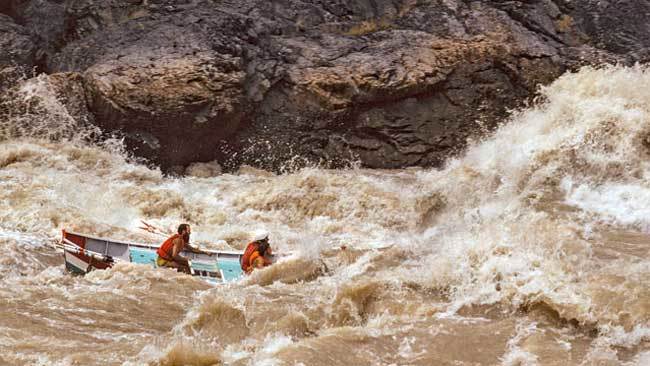
by Spreck | Aug 20, 2022 | Uncategorized

The thrill of whitewater: A dory and its passengers run the Grand Canyon’s Crystal Rapid in 1983, a high water year when unexpected late snowmelt threatened to destroy Glen Canyon Dam.
For almost 100 years, scientists, water agencies and environmentalists have known that the status quo on the Colorado River is not sustainable. Over the last two decades, population growth and especially low runoff have exacerbated an already untenable situation.
The dire conditions and impending changes in the Colorado basin are all over the news. The U.S. government and the many water agencies involved are negotiating future management decisions. Everyone will be doing some serious belt-tightening; some more so than others.
How did we get here?
The Colorado River Compact (aka the Law of the River) was signed in 1922 after an uncommonly wet 16-year period, when the river’s average annual flow measured 18.0 million acre-feet (18.0 MAF). (A single family home might use 1/2 an acre-foot per year).
The Compact’s hallowed text apportioned 15 MAF of river flow among 7 southwestern states (see below). An additional 1.5 MAF per year would be be provided to Mexico. The U.S. Bureau of Reclamation built huge storage reservoirs, including Lake Mead (holding up to 29 MAF behind Hoover Dam) in 1936 and Lake Powell (holding up to 24 MAF behind Glen Canyon Dam) in 1963, which together lose about 1 MAF to evaporation. So the total use of the Colorado’s flow plus expected evaporation would be about 17.5 MAF
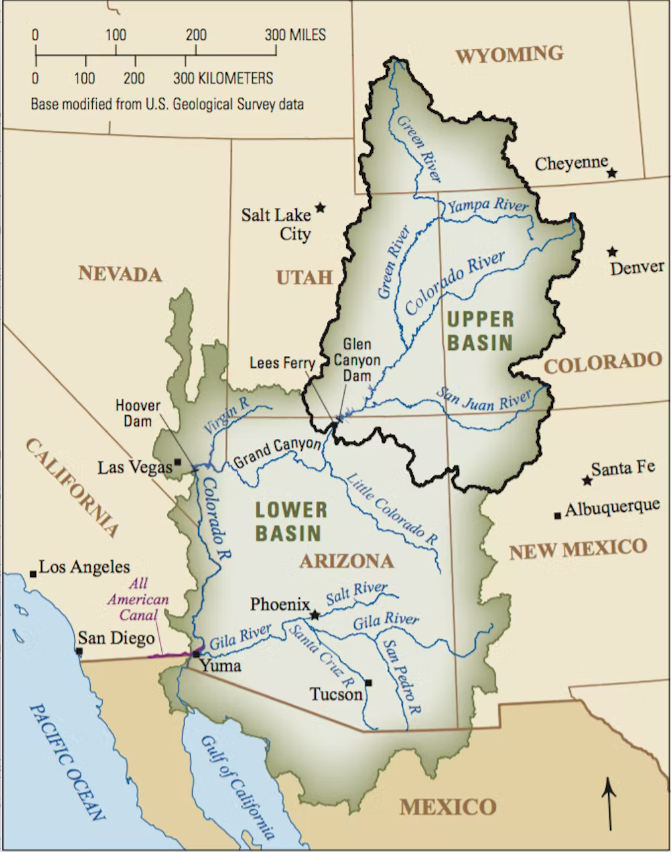
The Colorado has long been fully subscribed – it has been many decades since its flows reached the Gulf of California.
Between 1922 and 1999, however, Colorado River flows averaged only 14.6 MAF. Oops.

It’s surprising that the current crisis did not occur sooner. But some of the States were not using their full entitlements during the mid 20th century. And, as diversions increased at the end of the 20th century, there were a series of very wet years in the early 1980’s and late 1990’s (in 1983, high water threatened Glen Canyon dam – see the Bureau’s video or better yet read “The Emerald Mile”).
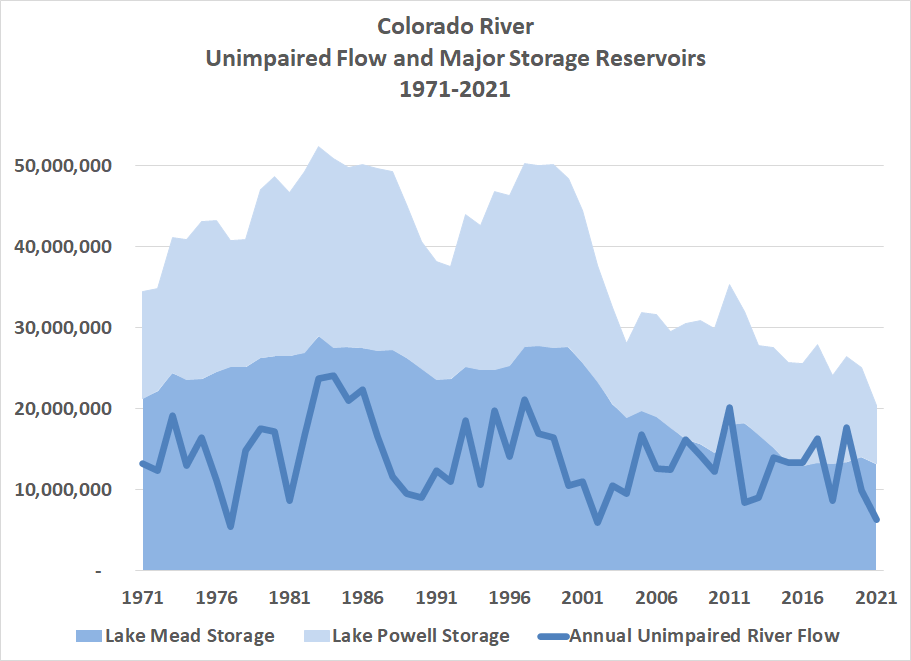
In the 21st century, however, there have been few high water years. In fact, the river’s flow has dropped further – to only 12.2 MAF. The system has been relying on withdrawing water stored in Lakes Powell and Mead. In 1999, these two mega-reservoirs held close to 50 MAF; today they are down to 20 MAF – a decrease of 60%
Whether the recent decline is the natural hydrologic cycle or has been caused by climate change is open to debate. What is not debatable is that cities and farms that depend on the Colorado must make major adjustments.
We are all concerned about water in the west. The situation at Hetch Hetchy is very different in that the Tuolumne River is a stream that feeds the Sacramento-San Joaquin Delta – a system that depends on water going out to sea, not only to sustain the environment but also to allow transport of water within California from the wetter north to cities and farms in the south.
Restore Hetch Hetchy does not take a position on how divide Tuolumne River’s water between diversions to the Bay Area, supply for farms in Turlock and Modesto and downstream flow to the Delta. We are committed, however, to replacing the storage that the O’Shaughnessy Dam provides so Hetch Hetchy Valley in Yosemite National park can be restored to its natural splendor.
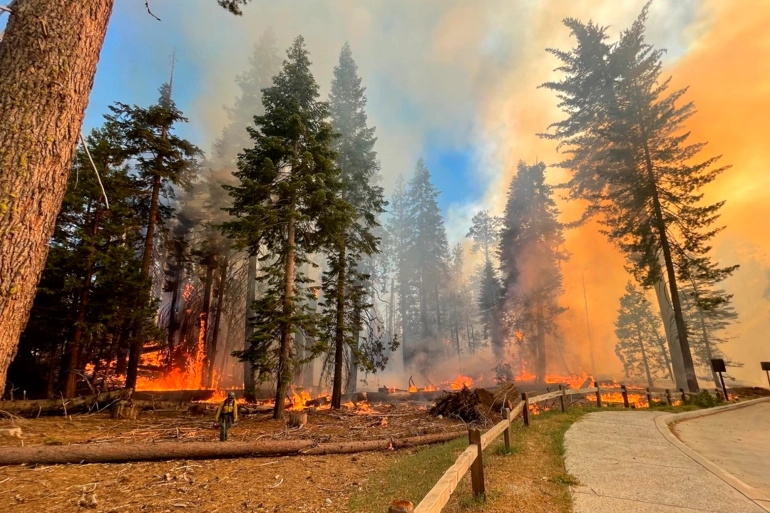
by Spreck | Jul 10, 2022 | Uncategorized
“To look upon a tree that antedates the Christian Era; that was in lusty vigor when Rome was founded; that is older than the Iliad, is a thing not to be passed over lightly. I came down from the mountain feeling as thought I had communed with the monarchs of the classic days.” – future President James Garfield in 1875

A firefighter walks near the Mariposa Grove as the Washburn Fire burns in Yosemite National Park, California, July 7, 2022 [National Park Service via AP Photo]
Historically, these magnificent trees have been resistant to fire over the millennia. But the plethora of devastating fires in California in recent years is scary stuff, and giant sequoias are true treasures. May they survive and continue to thrive.
And a huge thank you to the brave and hard-working firefighters!
—- President Garfield is among those inspired by his visit to the Mariposa Grove in 1875. A recount of this historic trip, originally posted on this blog two years ago, is below.
James A. Garfield of Ohio was elected to Congress in 1862. In his first term he voted on the unprecedented 1864 Yosemite Grant, later signed by President Lincoln, to cede Yosemite Valley and the Mariposa Grove to California “upon the express conditions that the premises shall be held for public use, resort and recreation.”
In 1871, with the Republican Party in control of both houses of Congress as well as the Presidency, Garfield was named head of the Appropriations Committee. (For those who may not know, the Appropriations Committee controls where the money goes.) James Garfield was one of the most powerful men in Washington.
That all changed during the midterm elections of 1874. In the biggest ever “flip” of the House, the Republicans lost 96 of their 203 seats. Garfield suddenly went from being one of the most powerful men in Washington to being just one of 293 Congressmen.
So what did James Garfield do? He went to Yosemite!
Garfield hopped aboard the transcontinental railroad, completed only six years earlier, and traveled to California. He then took another train to Merced, a stagecoach to Mariposa and finally traveled by horseback to what is now Yosemite National Park.
James A. Garfield was impressed by what he saw, but felt he was unable to put it all in words:
“(Yosemite) is one of the few things I have ever examined which has not been over praised. All description fails adequately to exhibit its greatness.”
Upon visiting the Mariposa Grove, Garfield wrote:
“To look upon a tree that antedates the Christian Era; that was in lusty vigor when Rome was founded; that is older than the Iliad, is a thing not to be passed over lightly. I came down from the mountain feeling as thought I had communed with the monarchs of the classic days.”
Garfield’s view of Yosemite Valley came as a snow flurry subsided. He wrote:
“After a sharp shower of ten minutes the sun burst forth in full splendor disclosing the wonderful beauty of Bridal Veil Fall and the grand doorway to the Yosemite formed by the El Capitan on the left and the Cathedral Rocks on the right.”
In a letter to his family Garfield wrote:
“Tell Mamma that in my late letters I have spelled it as two words, but I was wrong. It is only one word, Yosemite, and is pronounced Yo-sem-i-te, four syllables, accented on the second.
James A. Garfield traveled to Yosemite in 1875, five years before he was elected president of the United States. Many Presidents have visited Yosemite while in office, including Rutherford Hayes, Theodore Roosevelt, William Taft, Franklin Roosevelt, John Kennedy and Barack Obama.
No Presidents have visited Yosemite’s Hetch Hetchy Valley, but several Secretaries of the Interior have, including Richard Ballinger (Taft), Donald Hodel (Reagan) and Ryan Zinke (Trump). Secretaries James R. Garfield (Roosevelt, and son of President James A. Garfield) and Franklin Lane (Wilson, and former City Attorney for San Francisco), both of whom played key roles in damming Hetch Hetchy, never visited Hetch Hetchy.
Yosemite, including Hetch Hetchy, is rich in American History. Restore Hetch Hetchy is committed to writing the next chapter.
Much of the information above was derived from material posted on the internet by Ephriam Dickson, who researched Garfield’s trip via the Library of Congress. Our thanks to Mr. Dickson.

by Spreck | Jun 25, 2022 | Uncategorized

Jonas doing a “nosestand” in his kayak on the American River.
Environmentalist Jonas Minton passed on June 22, as a result of complications following heart surgery.
Jonas was most recently a water policy advocate for the Planning and Conservation League, where he was known for his knowledge, wisdom, integrity and good humor. He was never afraid to share his strong views about how water should be better and more fairly managed, nor to offer creative solutions.
Jonas also well understood the essential needs of cities and farms. He served as the Executive Director of the American River Water Forum, where he oversaw the sharing of the river between environmental uses and regional water agencies. Jonas also served as a Deputy Director of California’s Department of Water Resources (DWR).
While he was at DWR, a Hetch Hetchy meeting was scheduled in the Director’s conference room. Jonas stunned the small crowd by bursting through the back door, operatically bellowing “Yo Ho, Blow the Dam Down”. We restoration advocates were mightily amused; others not so much.
Most impressively, Jonas balanced passion with realism – he understood success required hard work and patience, and he was determined to have fun along the way. And, as he explains in the short video interview below, Jonas never demonized his adversaries – after all, he hoped to come to agreement with them down the road. Jonas’ spirit and counsel inspire us at Restore Hetch Hetchy. May he rest in peace.
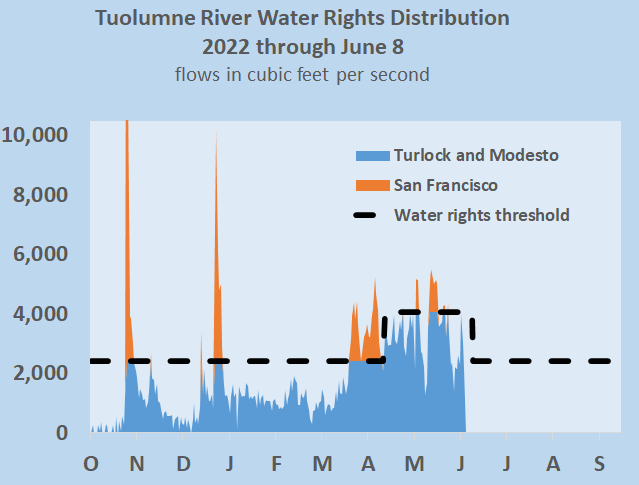
by Spreck | Jun 12, 2022 | Uncategorized

Early season storms provided substantial water to San Francisco under their junior water rights on the Tuolumne River. By the second week of June, however, the snowpack has largely melted and none of the river’s flow will likely be available to the City anyway – so the State Board’s curtailment order is likely to have no effect on its supply. Overall, San Francisco is doing pretty well water supply-wise this year, far better than most of California.
Due to our ongoing serious drought, on June 7 the State Water Board expanded its “Delta Watershed Curtailment Status List” to include San Francisco’s water rights on the Tuolumne River as well as some rights of the Turlock and Modesto Irrigation Districts. Erik Ekdahl, deputy director of the agency’s Division of Water Rights, described the restrictions — known as curtailment orders — as “significant” and “very deep.”
The story was covered with provocative headlines by both the Sacramento Bee (California tells San Francisco, Valley farmers to halt water diversions as drought worsens) and the San Francisco Chronicle (California orders thousands of farms and cities, including San Francisco, to stop pumping water during drought).
It does not appear, however, that the curtailment order will have any effect on San Francisco, and it may not even have any effect on the Turlock and Modesto Irrigation Districts (together, Turlock and Modesto use about 4 times as much Tuolumne River water as San Francisco and its Bay Area customers).
First, note that the order applies only to the limited snowmelt that still remains, not to water already stored in reservoirs or underground. Second, it’s highly unlikely that any river flows for the remainder of the water year would be available to San Francisco under their rights – the natural flow of the river would need to be over 2416 cubic feet per second (it’s possible but highly unlikely to be at all significant, see chart above). And thanks to the large storms earlier in the year, San Francisco is doing pretty well water supply-wise, far better than most of California.
It’s also not clear that the curtailment order will have any effect on the Turlock and Modesto Irrigation Districts. While some of the Districts’ water rights are curtailed, their longstanding “riparian” rights are not. See table below – extracted from the State Board’s massive spreadsheet, which identifies curtailment orders for 4571 out of the 16472 listed water rights in the Bay-Delta watershed.
No doubt many water rights in the Central Valley will indeed be affected, so the little flow available will go to those with the most senior water rights, and perhaps some will be left over to provide a sliver of relief for the Bay-Delta.
In many years, California’s cattywampus water rights system does not work very well for San Francisco. This year, with a significant ongoing drought, the City and its customers in other Bay Area cities are doing reasonable well.
| Principal Water Rights on the Tuolumne River |
| Application ID |
Primary Owner |
Curtailment Status
(Effective 6/8/2022) |
| S002635 |
SAN FRANCISCO |
Curtailed |
| S002636 |
SAN FRANCISCO |
Curtailed |
| A014126 |
TURLOCK I D & MODESTO I D |
Curtailed |
| A014127 |
TURLOCK I D & MODESTO I D |
Curtailed |
| S013848 |
TURLOCK IRRIGATION DISTRICT |
Not Curtailed |
| S013849 |
TURLOCK IRRIGATION DISTRICT |
Not Curtailed |











